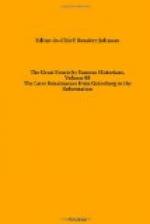Pope Sixties V and the Grand Inquisitor Painting by Jean Paul Laurens.
AN OUTLINE NARRATIVE
TRACING BRIEFLY THE CAUSES, CONNECTIONS, AND CONSEQUENCES OF
THE GREAT EVENTS
(THE LATER RENAISSANCE: FROM GUTENBERG TO THE REFORMATION)
CHARLES F. HORNE
The Renaissance marks the separation of the mediaeval from the modern world. The wide difference between the two epochs of Teutonic history arises, we are apt somewhat glibly to say, from the fact that our ancestors worshipped and were ruled by brute force, whereas we follow the broad light of intellect. Perhaps both statements require modification; yet in a general way they do suggest the change which by a thousand different agencies has, in the course of the last four centuries, been forced upon the world. Mediaeval Europe was a land not of equals, but of lords and slaves. The powerful nobles regarded themselves as of wholly different clay from the hapless peasants whom they trampled under foot, serfs so ignorant, so brutalized by want, that they were often little better than the beasts with which they herded. Gradually the tradesmen, the middle classes, forced their way to practical equality with the nobles. Then came the turn of the masses to do the same. The beginnings of the merchants’ movement we have already traced in the preceding volumes; the end of the peasants’ effort is perhaps even to-day scarce yet accomplished.
In dealing with modern history, therefore, every writer is apt to begin with a different date. Some go back as far as Petrarch, who reintroduced the study of ancient art and learning; that is, they regard our world as a direct continuation of the Roman, with the thousand years of the Middle Ages gaping between like an earthquake gulf of barbarism, that was bridged at last. Some take the invention of printing as a starting-point, feeling that the chief element of our progress has been the gathering of information by the poorer classes. Some, looking to political changes, turn to the reign of Louis XI of France, noting him as the first modern king, or to the downfall of Charles the Bold, the last great feudal noble. Others name later starting-points such as the establishment of modern art by Michelangelo and Raphael at Rome, the discovery of America, with its opening of vast new lands for the pent-up population of narrow Europe, or the Reformation, which has been called man’s revolt against superstition, the establishment of the independence of thought.
All of these epochs fall within the limits of the Renaissance, and all, except that of Petrarch, within the later Renaissance which we are now considering. The period is therefore worth careful study.




